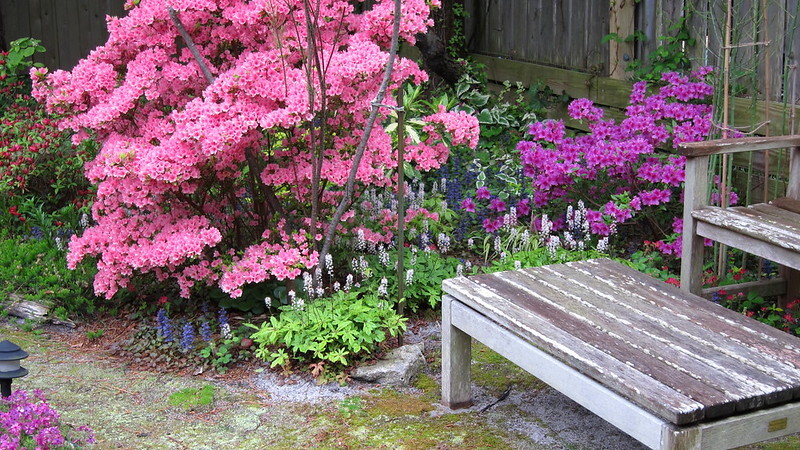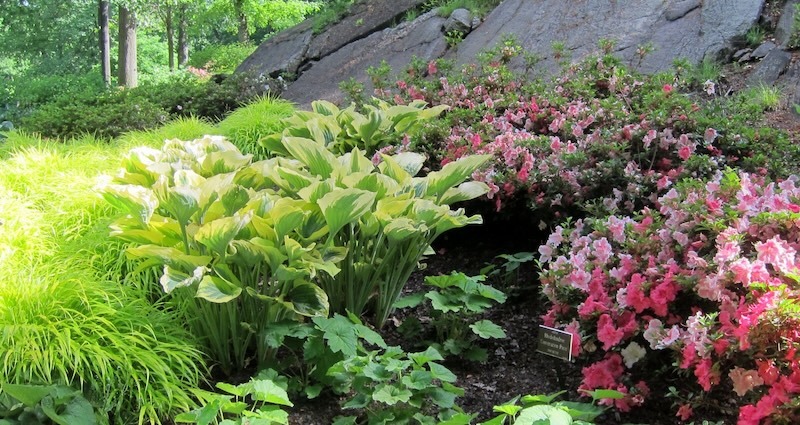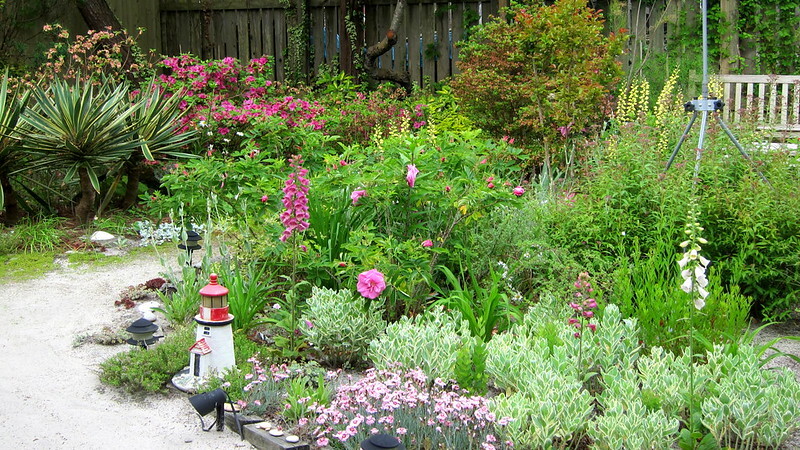Azaleas are often given the starring role in a garden bed. They can be broadleaf evergreens that give structure year round or tall, lanky deciduous types that have showstopping flowers early in the spring. Their blooms generously cover the plant, giving a pop of color when the rest of the garden is just waking up for the season.
Planning an effective design with Azaleas is easy as long as you keep in mind the conditions in which Azaleas prefer to grow in. Partly sunny to partly shaded locations that have acidic, fertile, and well-draining soil are perfect to keep Azalea shrubs thriving. For best results, plant azaleas with other plants that thrive in the same conditions. Also, consider the mature size of your Azaleas when choosing plant partners. Companions should either offset a large shrub by acting as a ground cover or act as a backdrop to a smaller-sized variety placed at the front of a garden.

Photo by K M, unmodified, Flickr, copyright CC BY 2.0
Shrubs To Plant With Azaleas
Many other evergreen and deciduous shrubs mix nicely with Azaleas. Abelia and Hydrangea are blooming shrubs that will continue to flower well after the Azaleas are finished. These two shrubs look best when used as a backdrop for the smaller forms of Azaleas. Cleyera and yew other broadleaf evergreens that, like Azaleas, helps give structure to a garden design. Use them as a hedge or as specimen plants to set off your azaleas.
Surprisingly, acid-loving berry shrubs including blueberry, cranberry, and lingonberry make great partners with Azaleas. Look for low-growing varieties to use as edible ground cover or larger types that will also have a glorious fall display of colorful foliage.
Perennials To Plant With Azaleas
Perennials are the most versatile plants in the garden. They provide seasonal color, foliage texture, and valuable weed suppression during most of the year. Fortunately, Azalea mixes well with just about any perennial that likes a slightly shaded location with acidic soil. Look for Astilbe, bleeding hearts, ferns, ornamental grasses, and Hostas to add dimension and foliage texture that contrasts with Azaleas’ often smooth, small, and dark leaves.

Photo by K M, cropped, Flickr, copyright CC BY 2.0
Evergreen perennials such as Lenten rose and Brunnera can be added to Azalea plantings to provide color in the winter months. Ground covers such as sweet woodruff, bunchberry and Ajuga thrive in moist acidic soils, like Azaleas do, and are easy to grow. Perennial spring bulbs such as daffodils, crocus, checker lilies, and ornamental Alliums are natural companions and can be used to highlight or contrast the bright colors of Azaleas in full bloom.
Annuals To Plant With Azaleas
Annuals that flower early in the spring include the tried and true hardy varieties of pansy, Violas, Dianthus, larkspur, and Alyssum. Drifts of white Alyssum look fabulous planted as a weed-suppressing groundcover under Azaleas. Pansies, Violas, and Dianthus will provide wonderful color all spring until the weather turns hot in early summer. Try planting one annual in large drifts to stand up to the size and shape of Azaleas.
For a harmonious and relaxing feel to the garden bed, choose colors next to each other on the color wheel, such as purple and blue flowers. For greater visual impact, try pairing flowering plants with contrasting colors, such as purple and yellow. Using annual plants as companions for Azaleas means that the gardener can try a new or unusual combination that can be changed from year to year without the commitment that perennial plants take.

Photo by K M, cropped, Flickr, copyright CC BY 2.0
Best Companion Plants For Azaleas in Containers
Azaleas are generally planted in containers by themselves. However, if you have a planter that is large enough for more plants, there are many combinations of filler and spiller plants to add to an Azalea. Keep in mind that Azaleas appreciate partly shaded locations, especially at the hottest times of the day, so you should look for perennials and annuals that thrive in shadier conditions.
Ferns of all types, small variety Carex grass, and Alyssum make great filler plants while adding contrasting texture with their foliage and flowers that bloom later in the spring or summer. Lamium, Helichrysum, and Petunias are long-lasting, blooming spillers that work best in containers either in part shade or full sun. Keep the container well watered and make sure the container drains well throughout the year. Fertilizing mixed planters is imperative to ensure vibrant foliage and flower color. Use a diluted liquid seaweed or fish emulsion feed once every 2-3 weeks.
Plants Not to Grow With Azaleas
Plants that are considered drought tolerant or thrive in alkaline soils do not make good partners for Azalea, including lavender, hardy geranium, clematis, goldenrod, and yarrow. The soil conditions that Azalea needs to bloom and grow well would lead to all kinds of problems for most drought-tolerant plants. The acidic soil Azaleas need also does not release certain micronutrients that are readily available in soils that are on the alkaline side of the pH scale. Coneflowers, black-eyed Susan, and most herb plants should not be considered when designing a garden bed around Azaleas.
Best Plants To Grow With Azaleas
Choose plants that have the same soil requirements that Azalea has. This will guarantee that your garden is lower maintenance and better able to resist invasions from pests and diseases. Choose plants that are early spring bloomers to complement Azalea's bright display of color, or choose more understated plants that will continue providing color long into the summer. Classic shady garden plants including Hydrangeas, Astilbe, Lenten rose, Hosta, Ajuga, and Japanese forest grass are all great choices that never go out of style.
 |
Author Alison Cotsonas - Published 08-01-2023 |
